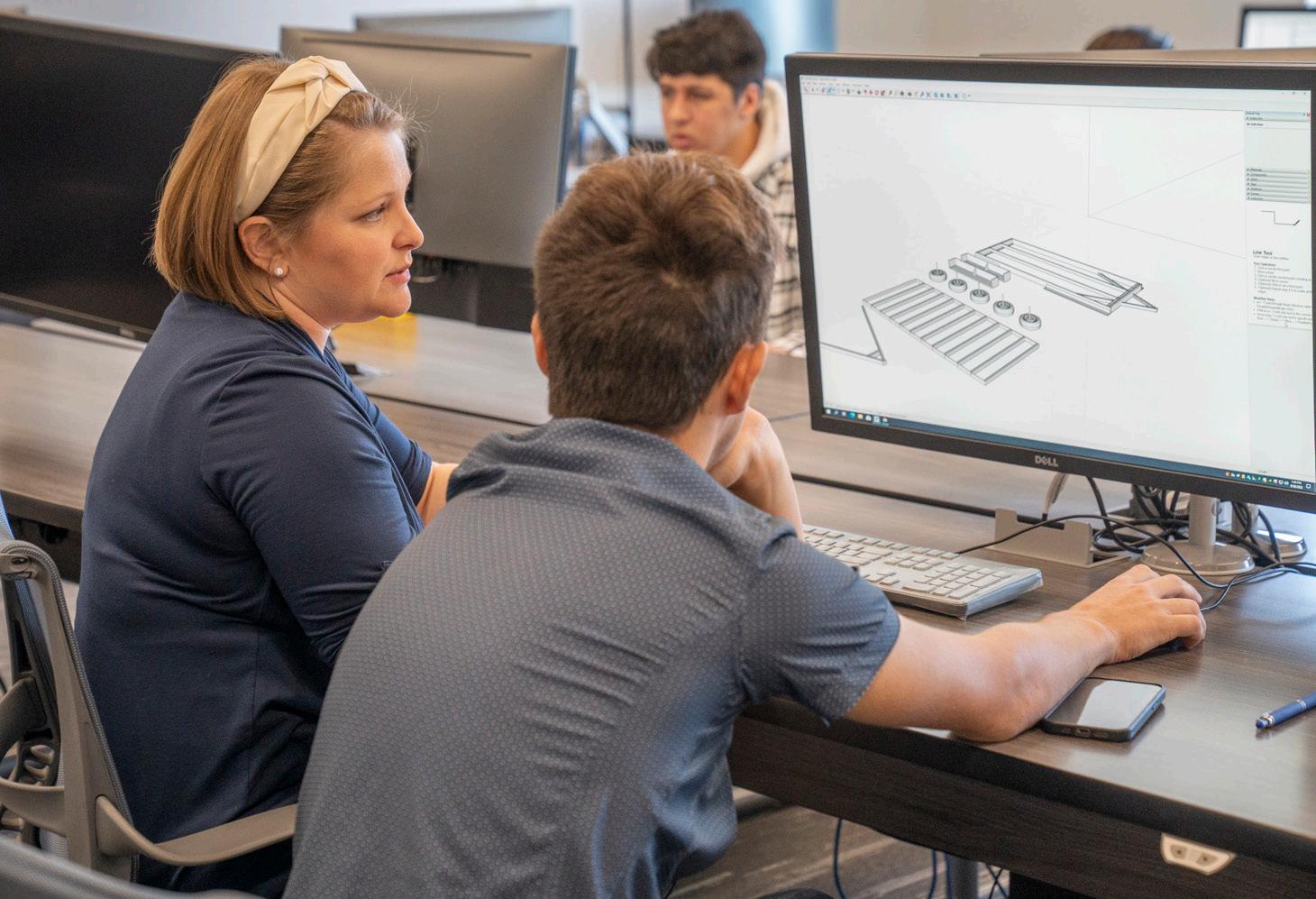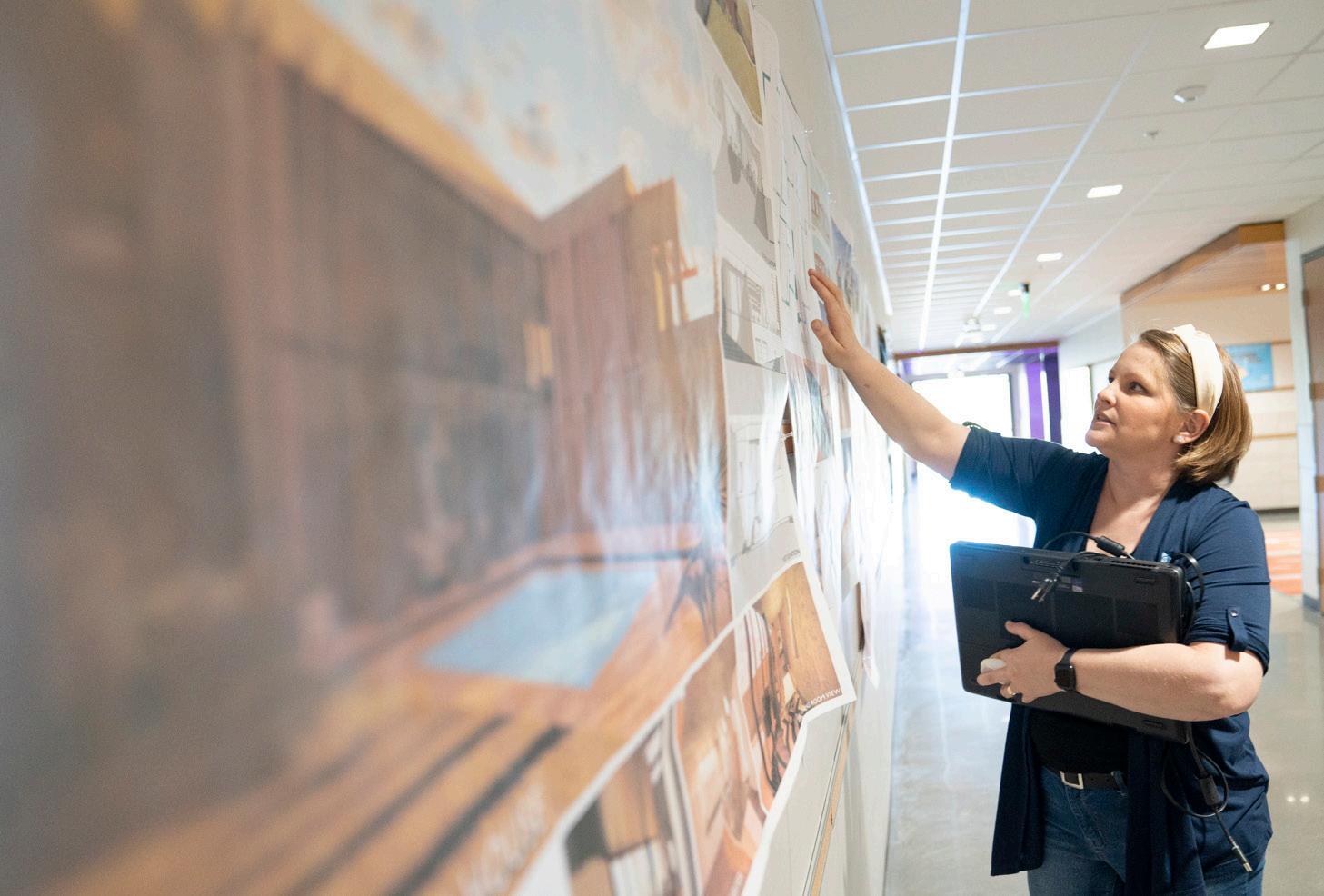
9 minute read
AIA Nebraska honors Ling for expanding access to AEC careers
Seeking work-life balance, Stephanie Ling decided to leave her career as a working licensed architect in 2017 to pursue work in higher education. While she was interviewing to become an instructor at Metropolitan Community College, she imagined how she could shift the focus of the Architectural Design Technology program to position students for success.
Her goal: Expand access to architecture, engineering and construction (AEC) careers to meet a growing workforce demand.
“I saw the opportunity and could tell this was going to be a good change for me,” Ling said.
What was a good career change for Ling also worked out well for the local AEC industry and for students seeking careers in it. Ling’s decision to go into education was validated by her peers. The American Institute of Architects’ Nebraska chapter recognized Ling’s contributions to the profession, presenting her with the 2024 Architectural Design Education Award.
Designing her future

Ling was immersed in design growing up. Her mom, Anne Peterson, is a retired licensed landscape architect, and her younger brother, Joel Peterson, is a licensed professional engineer for HVAC systems. Ling also started a family with husband, Jay Ling, a professional engineer and project manager.
Ling credits her mother, as well as her husband, as key influencers in her decision to change careers. Anne’s determination and resilience as a single mother working in a male-dominated field in the ’80s and ’90s shaped how Ling viewed work.
“She was the only woman who wasn’t a secretary on two floors at her company. As a single mom, she really struggled to work in the man’s world of 9 to 5,” Ling said. “If we were sick, she couldn’t work those hours and ended making up the time overnight. Sometimes we’d sleep under her desk at the office. So, Joel and I, we just had this experience of tenacity.”
After nearly a decade in commercial architecture, Ling entered education just as 3D building modeling software like Revit was revolutionizing the field through its efficiencies in project design, documentation and management. The problem: the industry lacked a workforce trained to use it.
Becoming a licensed architect typically involves a combination of an accredited bachelor’s or master’s degree, on-the-job-experience and passing a series of lengthy exams. Today, the education portion of this process takes a minimum of five to six years. By contrast, the MCC Architectural Design Technology program helps students get access to emerging careers in the field in two years, a huge benefit to the industry and to students by shortening the timeline to access entry-level jobs with sustainable wages.
“People need skills to go to work in two years, not just in four or six years. I’m always looking for ways to make the program more accessible without undermining the quality of what students are learning,” Ling said.
Expanding experience in BIM
Transitioning the program to meet the broader AEC industry needs was challenging, but it made for a far more relevant program, beneficial to more area companies.Before a program like the College’s existed, learning building information modeling (BIM) software happened on the job — and at a high training cost for a licensed architect or design firm. To Ling, leaving a technology so fundamental to the industry out of formal education seemed like the kind of inefficiency BIM software exists to rectify.Traditional architecture programs may spend as little as six hours of BIM-specific training across six years. At MCC, students spend a full year on it.“Stephanie has worked to shift the focus of the architectural design program to better serve the AEC industry’s needs for qualified building information modeling technicians and innovative design thinkers,” wrote Ross Miller, principal at FormGrey Studio in the AIA Nebraska nomination letter he submitted on Ling’s behalf. “[Before Ling developed the MCC program,] the only option for students to earn a National Architecture Accrediting Board-certified degree in architecture in the state of Nebraska was to attend the program at the University of Nebraska-Lincoln (UNL). It is critical that students in Nebraska have additional options and opportunities to pursue a professionally accredited architecture degree.”When Ling began working at MCC, the architectural design program was hosted at the Elkhorn Valley Campus and the curriculum was more relevant to the creative arts and hobbyist home designers. Fewer than 30 students were enrolled in 2017. By the 2023-24 academic year, the program’s headcount rose to 169, from 89 in 2021-2022. By the close of the current academic year, more than 30 students are expected to complete their MCC Architectural Design Technology program of study.Ling grew the program by creating a foundation of knowledge for students to be able to speak the language of architecture, understand the processes the AEC industry relies on and have the same aptitude on a construction site. Several core classes within the program prioritize off-campus tours to industry partner companies and active jobsites to facilitate students’ ability to connect what they’re learning in the classroom to the real world.“Classic architecture school does not teach the practicalities of buildings. They put being a designer on a pedestal. They teach you to design think, design problem-solve and design make, which is great, but only about 20% of architects end up designing on a day-to-day basis,” Ling said.That leaves a majority of professionals starting their careers in architecture with high ability but lacking some of the basic language used in team meetings or knowledge of how all the AEC professions work together.“It’s terrible when you enter the industry with this design skill set but you don’t know what anything is called or how anybody works together. You don’t know how to use the software. You’re expected to teach yourself every day. It’s just really overwhelming,” Ling said. “My goal is to help our students feel confident to be in a room with professionals, working on real projects and to be inspired to teach themselves, but within a framework that they could learn the basics of Revit so they can run with it when they get to industry.”Now housed at the Construction Education Center at the Fort Omaha Campus, MCC Architectural Design Technology students learn alongside students developing skills used by trade partners of architectural firms, like general contractors and subcontractors.With an MCC associate degree, graduates of the program are qualified for careers as BIM managers, specialists and technicians, as well as Revit drafters and more. In addition to these core architectural technology jobs, construction companies are creating virtual design and construction (VDC) jobs, an area of exponential industry employment growth MCC students can step into upon completion, Ling said.Wholly unrelated industries also have needs for workers with 3D modeling skills, such as manufacturing, real estate and even gaming. BIM technicians have the applicable educational background in demand by these sectors.“Builders are using the models that BIM designers create to make construction better. At MCC, we’re trying to create a whole group of people who can be helpers to industry,” Ling said.MCC is also a resource for graduates of four-year institutions like UNL, Iowa State and Kansas State seeking to advance their design skills through continuing education. The College’s quarter structure allows working professionals to take advantage of multiple course offerings with a shorter time commitment.“Redesigning the program was stressful and overwhelming, but after two years, we started to reap the benefits. People are starting to springboard into careers and come back to me and tell me, ‘I have this awesome job,’” Ling said.One of those students was Amy Sexton, who is nearing completion of her architecture bachelor’s degree and professional license. She credits Ling’s leadership of the program and 1-on-1 guidance to helping her reimagine her career midway through it.
Leveraging technical skills during the creative process

One of Sexton’s favorite experiences on the way to her associate at MCC was working with Ling and two other architecture design technology students on drafting the building plans for one of the Capstone houses that MCC Construction and Building Science Technology students used when assembling a modular home. At the end of the school year, the affordable house was transplanted and sold in the nearby Miller Park neighborhood.
“We were doing the drawings that the construction students were building right behind us. As we finished our design, they were literally building it out. To go into that bay and see it being built was so impactful. It was so exciting. It felt really small on paper. Someone’s living there now,” Sexton said.
Sexton credits Ling with providing added value during her education through her general availability to students and through mentorship. Ling has maintained her architectural license since becoming an instructor at MCC. Sexton said Ling’s connections to industry were helpful in keeping her informed about opportunities for further development. Ling also helped Sexton refine her portfolio.
Sexton said she helped herself by letting her eagerness to learn be known through classroom participation and taking pride in her assignments. Daniel Bolt, the founder of architectural firm SCOPPA, who also works as an adjunct instructor at MCC, took notice of Sexton’s engagement in the program, her determination and the quality of her student work. Bolt offered her contract work, which eventually turned into a full-time job as a designer at the new architecture firm.
“Working at SCOPPA is exactly what I was looking for. Being at a small firm, where I’m the first employee, I get to work on projects from start to finish. It’s been really formative, and it’s what is allowing me to be able to look at getting licensed within the next year,” Sexton said.
Ling said accepting the education award from AIA Nebraska at the University of Nebraska’s School of Architecture as an instructor at a community college underscored the importance of a new avenue for career education in the field.
“What meant the most was that architects recognized how this program expands access to the field,” Ling said. “We created something that didn’t exist before at MCC, and now people have another way in.”
Ready to draft the plans for a rewarding career in architectural design technology? Visit mccneb.edu/Architectural-Design-Technology to learn more about degrees and certificates offered.

